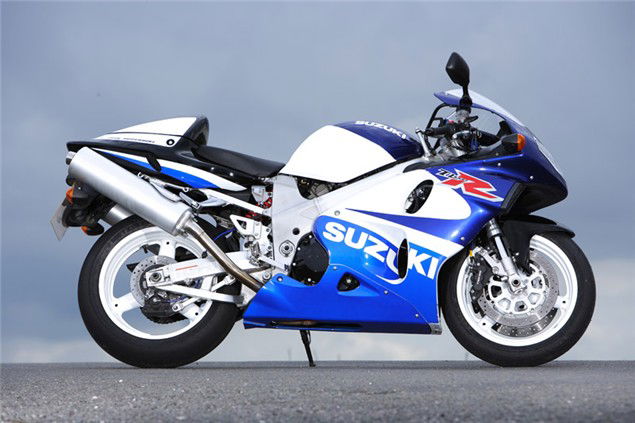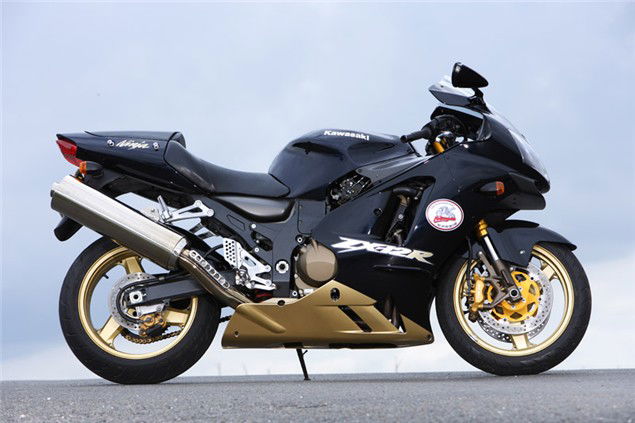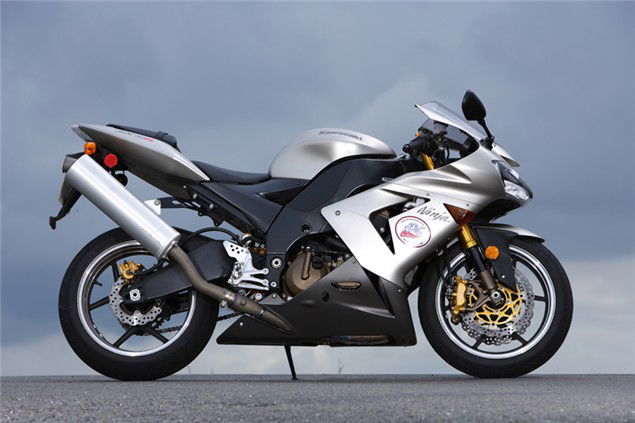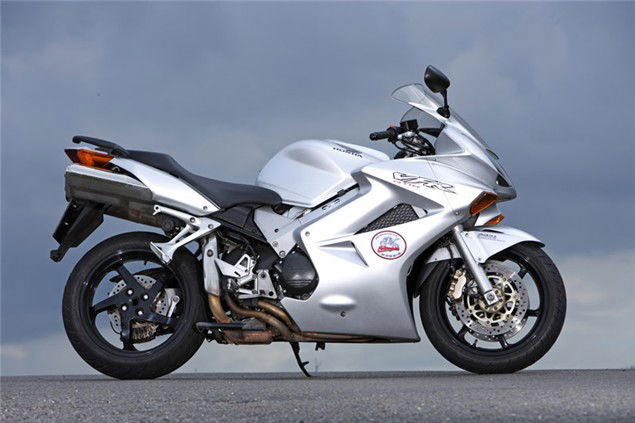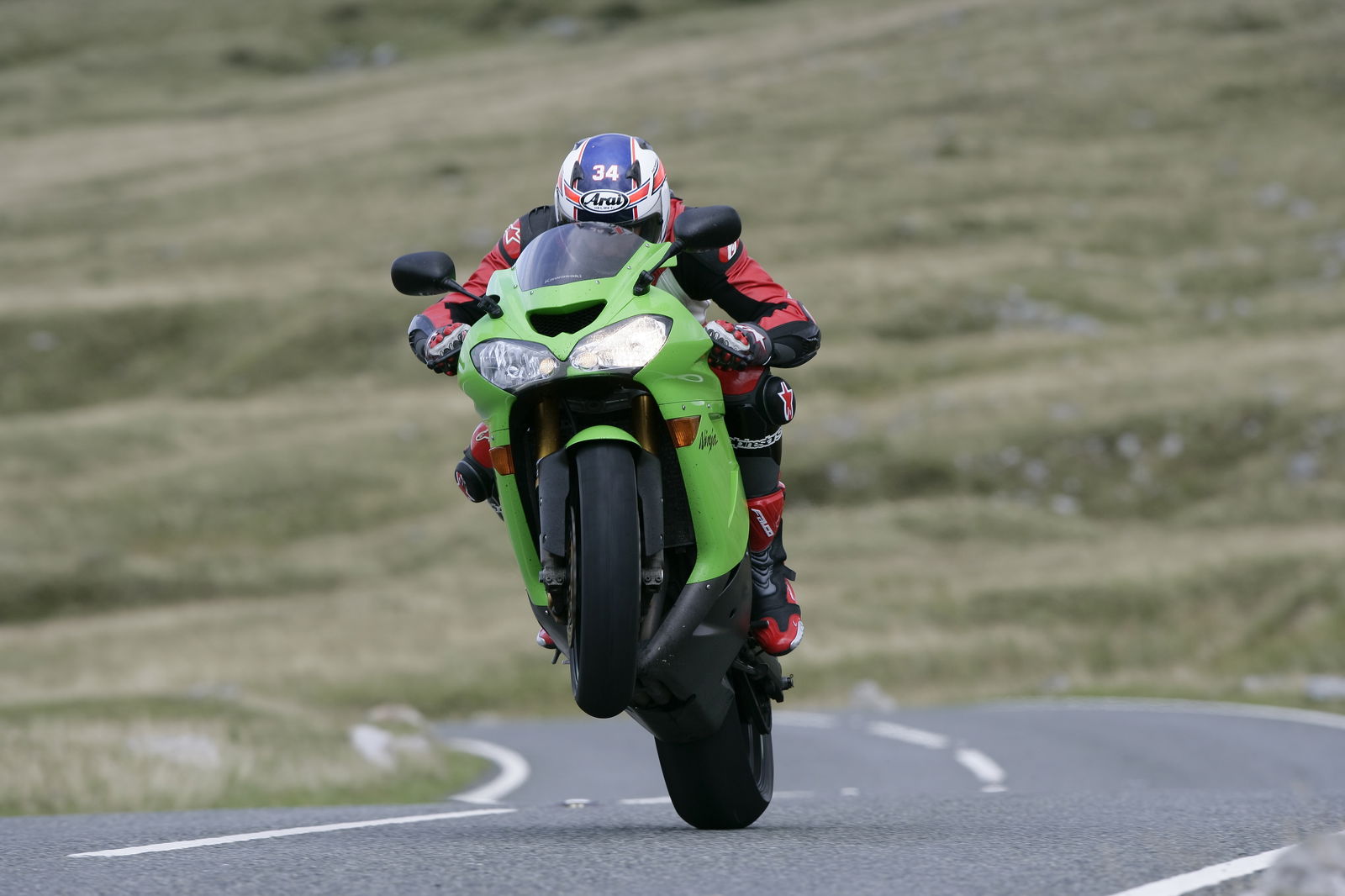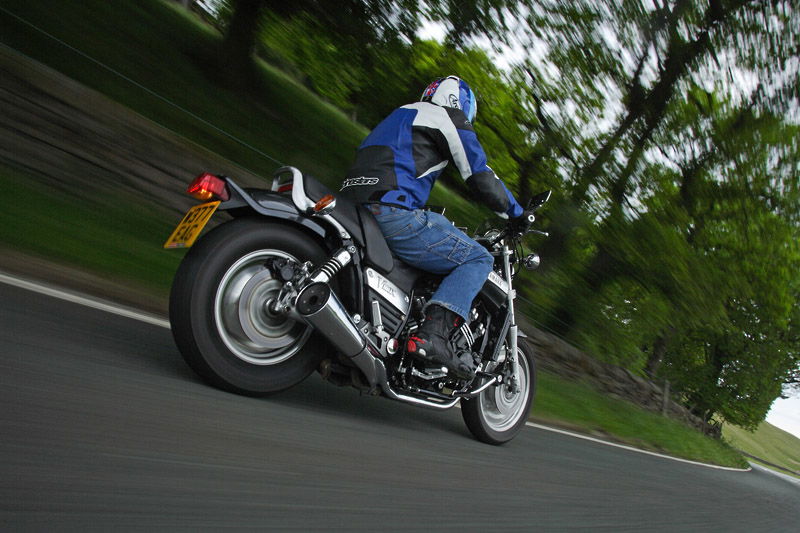Insurance Refugees: TLR, VFR800, ZX-12R & ZX-10R
Some secondhand bikes have slipped through the insurance net and can be bought and insured for less than half the price of a new supersport machine. We grabbed a 22 year-old student and found the most ridiculous insurance deals on these four

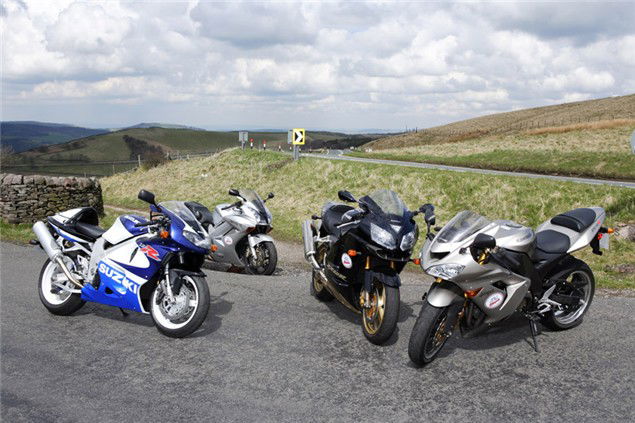
Insurance has always been a dirty word in motorcycling. Spiralling annual premiums and the crippling cost of having your bike covered puts many riders off owning a high-performance machine altogether, so much so that many manufacturers are being forced to offer subsidised insurance deals to entice customers towards their flagship models.
Which is all very well and good until the renewal notice drops onto the doorstep. To insure a 1,000cc bike on the road will often cost twice the amount of your house’s contents cover, and four-figure sums are common. And it’s even worse if you’re young.
If you’re under 30 and don’t have a garage then owning and insuring a decent big sportsbike is likely to cost you the earth. Or is it? We did some digging around and found that with some research there are superbikes that for some reason have been over-looked by insurance under-writers. They might not be the latest machinery, but these are bikes that will leave you panting from their performance and laughing at their cost.
And just to prove how cheap they are to insure, we got quotes for our work experience kid, a 22-year old student living in London asking for third party insurance. He represents just about the worst possible risk, so your cover will be cheaper. And look at what you could be riding...
��
SUZUKI TL1000R
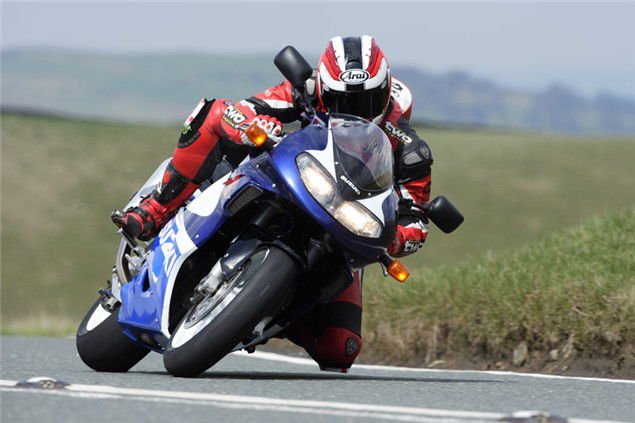
SUZUKI TL1000R
The TL1000R was Suzuki’s homologation answer to the dominance of the Ducati 916 in WSB, but like an overweight Joe Bugner wobbling into the ring to get a thorough pasting by Frank Bruno the TL was never up to the job. Everything about the TL1000R was poorly timed. It appeared at the height of its TL-S brother’s handling uproar and was never the Ducati-whooping WSB bike that pre-launch hype hinted at. Sales were poor, the racing never happened, and six years later R was dropped from Suzuki’s range. All of which culminated in the R becoming a black sheep in the two-wheeled flock.
Which is why, having never ridden one, I tended to snigger at TL1000R owners. Let’s be truthful here, it isn’t really a looker. The gigantic arse end is ridiculous and the front bulbous and ungainly. But, as I now have found out, it was the TL owners who had the last laugh. Because the R is a lovely bike.
Sitting on it the first thing you notice is the enormous and generously padded seat. It’s fantastically comfortable, as is the riding position and all encompassing fairing. The TL feels like a big bike, and sort of absorbs you into its folds, when you sit on it. It’s nothing like the sportsbikes of its day and feels more like a sports tourer. Which probably played a large part in its lack of success, but is this necessarily a bad thing?
Having sampled the TL1000R I’d say no. As a secondhand buy a good TL would be a great purchase for a day-to-day superbike. As well as being comfortable the TL has a fantastic engine. This V-twin lump is no stranger to the motorcycling world having found its way into various V-twins but these have all be ‘re-tuned’ versions, and the original is by far and away the best. From the moment you let the clutch out the twin surges forward with a flat and monotone drone. The engine itself makes absolutely no noises, which is typical Japanese, and has a completely flat power delivery. Unlike Honda’s SP-2, which has a bit of a kick at the top, the TL just drones its way forward with no real noticeable powerband. It’s relaxing, easy and, in keeping with the rest of the bike, very user friendly. It may only make, by current 1,000cc standards, a fairly modest 120bhp but this is more than enough for road use.
It was the issues with the S that made Suzuki change its mind at the last minute about what it was planning to do with the R, because everything about this bike feels softened. From the power deliver to the slightly soggy suspension which gives a wallowy ride in corners the TL-R is a sportsbike that has been blunted. But for road riding this is no bad thing. The R is a great road superbike and would make a fantastic tourer. Just get used to the look.
MATT’S STUDENT RUBBISH
In my short motorcycling life I have owned an SV650S, so I was understandably excited to be given the opportunity to sample Suzuki’s V-twin monster. For a used bike the TL had been meticulously well looked after with everything from clutch to brakes performing with effortless fluidity. I felt less crammed on the TL than the 2008 ZX-10R as she was fairly wide and spacious. As appears to be the norm with V-twins the TL offered stacks of low down grunt in the lower gears, rapidly climbing up to her short 11,000rpm redline. I found myself kicking up and down between second and third constantly so as not to rev it too high. Trying my best to take the odd corner with a bit of pace I noticed at times that the rear did have a tendency to slightly wobble. For someone of my inexperience this is a machine that can dangerously nurture over-confidence. Not the cheapest of this lot for me to insure, but it’s a cool-looking retro bike and for 3 grand this is a whole lot of bike for the money.
HONDA VFR800 V-TECH
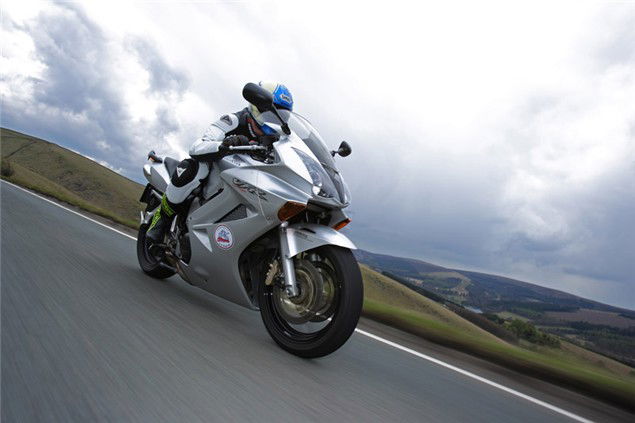
HONDA VFR800 V-TECH
Every now and then Honda loses the plot ever-so slightly. It doesn’t happen that regularly, but when it does it’s always a surprise. This model of VFR is a case of Honda taking its eye off the ball and getting caught up in an excitement over new technology.
It all stems from Honda’s VTEC system, which the company uses brilliantly in its cars. VTEC is a clever valve arrangement where at low revs the engine runs on two valves, increasing the low-end power, then at a pre-determined limit, two more valves start to operate, making the motor a four valve head, which is better for top end power. All very clever, except on this model the transition between two and four valve comes with a horrible jerk.
When you’re riding outside the transition period the engine is lovely, with loads of low-down torque and a quick top end. It sounds good too, with a V4 growl emitting from the stylish underseat pipes. But, and here is the catch, at 7,000rpm it all goes wrong. With a clunk the engine changes mode, not too much of an issue if you are accelerating through this period, but 7,000rpm in top is almost exactly motorway cruising speed, meaning you are continually lurching in and out of two/four valve mode, which is really, really annoying for everyone.
The rest of the bike, as you would expect, is typical Honda quality. The VFR has long been established as the sports-touring benchmark and you can see why. The riding position is a perfect balance between sport and touring, the finish superb and it still looks good today. On the go the Honda has surprisingly light and responsive handling. You can have a really good thrash on a VFR and not feel like you are riding a tourer, nor that your mates on their sportsbike will clear off. Honda’s combined braking system can make the brakes feel a bit unresponsive, but is easily acclimatised to.
It’s a great bike for a weekend away and once you get shot of the pillion you can have a blast thanks to the excellent chassis. But, and here is a big but, I wouldn’t buy this model. Get the previous model VFR800, or the next generation VTEC, depending on how deep your wallet is.
MATT’S STUDENT RUBBISH
Looking at the VFR I thought it looked like a quirky sports bike, but upon firing it up and taking it down the road everything started to fall into place. The VFR had a very comfortable upright position that gave good visibility ahead and a power delivery that wasn’t too snatchy, definitely the breedings of a well-rounded sports tourer. Special mention has to go to the clocks that were so comprehensive I half expected radar to pop up showing nearby speed traps. The brakes were responsive, the gears snapped effortlessly into place and the engine had clearly never missed an oil change. However, there was no getting over the fact that she was a tad on the bulky side, mostly noticeable at slow speeds and on the sharper corners. But this didn’t stop me getting her to some pretty leery speeds when presented with a straight enough road. But I couldn’t get over the fact that it was, perhaps, a tad bland. Cheap to insure but too much an old man’s bike for me!
KAWASAKI ZX-12R
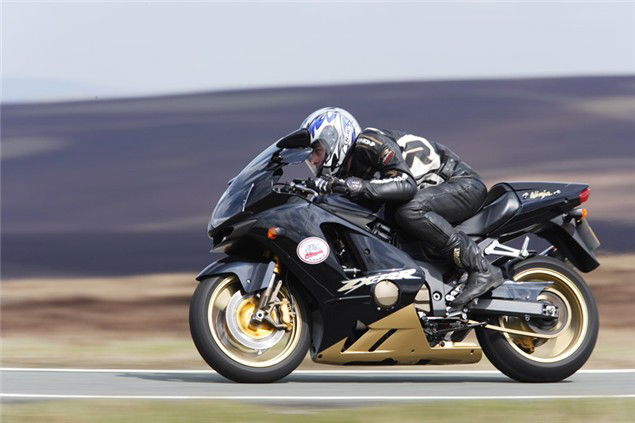
KAWASAKI ZX-12R
I’ve had some insane trips across Europe on ZX-12Rs, holding silly speeds for miles on end in a flat-out dash to use as much fuel in as shorter time as humanly possible. It’s a gloriously fast machine that has absolutely no excuse for existing if you look at the figures.
Why do you need a bike with genuine 165bhp and a restricted top speed of 186mph? The answer is you don’t, but that’s not what the ZX-12R is good at.
This bike is dominated by its engine, and it’s the sheer size and magnitude of the motor’s torque that sets the Kawasaki aside. You don’t need to go fast on it because, perversely, it has so much power. Owners tend not to hit warp speeds, instead they ride around at legal speeds savouring the fact they don’t have to continually change gear to overtake, rev the engine or even work it remotely hard, this is the ultimate lazy man’s bike. A huge twist and go, if you will.
It’s this fact, I’m sure, that has kept its insurance down. But don’t think for any moment that the ZX-12R is a pussycat, get it wound up the Kawasaki is a missile. As with any of the hyperbikes the power never seems to stop coming on the ZX-12R. Just when you think it must slow down the airbox roars a bit more, the torque keeps flooding in and the speedo whips around another few degrees. You have to experience acceleration on a ZX-12R once, it’s staggering.
But, unfortunately, the rest of the bike is a bit forgettable. I think of the ZX-12R as a sportsbike that has been shoved in a photocopy machine and reproduced at 120%. It looks, from a distance, like a sportsbike, but get on it and it feels big and a bit lumbering. I’ve always found that ZX-12Rs feel too long, which makes then cumbersome to turn. The feedback from the back end is never that clear, which has potential disaster written all over it considering the power of the motor. But this is the price you pay for stability, because for motorway cruising it would take a force 9 gale to shift the Kawasaki from its course. It’s a mile muncher that is also fairly comfortable.
I only say fairly because, personally, I don’t get on with the ZX-12R’s riding position, I prefer either the Blackbird or ‘Busa, but others disagree. It’s personal taste, I find the Kawasaki is too upright and exposed and prefer a slight racing crouch that you get on the Hayabusa, also I find the seat a bit unforgiving.
Considering what you are insuring it’s ridiculous that you can insure what was the most powerful bike made in 2001 for less than a modern 600. If you’re on the big side the ZX-12R makes a lot of sense, especially if you cover a lot of straight line miles or are planning tips to Europe. Although the handling is never going win any prizes the finish is excellent, ride plush and the engine will re-define your perception of what fast feels like.
MATT’S STUDENT RUBBISH
Like a love struck adolescent I just can’t stop gwaping at the ZX-12R. All 6 feet of me sits aboard this bike and feels comfortable courtesy of the wide full fairing and spacious seat. I was initially concerned that the 12R was going to be a cruise missile that was so bulky and explosive that I’d have to be on DEFCON 5 at all times. How wrong I was. Although immensely powerful across the range the delivery is so progressive that it never feels intimidating, and post 30mph the weight evaporates. Although the engine and gearbox are sweet as a nut, the brakes at times felt a little spongy. This only really caused a problem when I hurtled into a corner and grabed the front, expecting a similar performance to the TL1000R and ZX-10R, which the 12 doesn’t quite deliver. Taking it through the motions at any corner the ZX-12R also showed a little reluctance to lean, this is a bike you have to make an effect to muscle about. Out of these bikes the ZX-12R made me smile the most, but with one in the garage I’d expect to lose my license within a year. I just don’t have that much self control!
KAWASAKI ZX-10R

KAWASAKI ZX-10R
When Matt said he could get insured on an original ZX-10R for less than £400 I didn’t believe him. This is probably the most hardcore litre bike that has ever been made. Honestly, this thing is bloody barking.
When it was launched in 2004 we all agreed that this was just too much. Too rabid, too ferocious and down right scary to ride on the road, especially without a steering damper. Kawasaki had taken the philosophy of shoehorning a 1,000cc engine in a 600 chassis to the extreme.
Has it mellowed over the years? Has it hell! I honestly don’t think that riders should be allowed near bikes like this unless they have a minimum of five years’ riding experience. Yes, the throttle goes both ways, but it’s just so easy to get caught out on a ZX-10R and allow the bike to get ahead of your ability.
The ZX-10R doesn’t accelerate, it explodes forward like a barely controlled ground-based missile. The engine is awesome and revs so quickly your brain struggles to comprehend what is happening while your ears are deafened by the airbox snarling below. It was, and in many ways still is, the ultimate 1,000 motor when it comes to raw power.
And the handling matches the motor. The TL1000S might have gained a reputation as a bit of a slapper, but compared to the ZX-10R it’s a nun. Kawasaki deliberately gave the ZX-10R the handling of a 600 race rep, and along with lightning turning comes a lively front end. Much of this is due to the rear shock, which was never a great unit, but the simple fact that if you give a 600 chassis over 155bhp it is going to be lively. There is no way it wouldn’t, physics says so.
Many riders find the raw feel of the ZX-10R a major selling point, and I don’t blame them. There are few bikes out there that are so exciting to ride and provide such a buzz. Sometimes it’s nice to feel that you are only just in control, dicing with physics and taming a wild beast. If this sounds like you then jump in!
MATT’S STUDENT RUBBISH
Having had no experience on a litre bike I was a little apprehensive about trying my luck on the ZX-10R. After sitting aboard and starting the engine I instantly learn two things, firstly that it weighs next to nothing and secondly that there’s far more power down there than I’m ever going to use. Everything happens with such urgency it was initially overwhelming compared to what I’m used to. Even with the slightest twist of the throttle the revs build with alarming pace, propelling me forwards at a speed I daren’t confirm on the minimalist clocks. Even at post 100 speeds I never find a reason to exceed third gear. And when I slowed proceedings down it felt like I was going to pull an unplanned stoppie, such was the sharpness of the brakes. The whole bike exudes a feeling of focus and precision, the gears switch instantaneously and it leans effortlessly. It seems insane that someone of my biking experience could insure this for £400, but I’m having so much fun this fact is quickly forgotten. I’d be stupid to buy something this focused as a day to day ride, but then again, don’t stupid people have more fun?
Conclusion
Conclusion
On the face of it the ZX-10R is the bike we would all snap the insurer’s hands off to get covered on for so little. How on earth does a bike as rabid as the original ZX-10R slip through the net? But ownership of the Kawasaki also brings its own set of problems. If you are young then the only option is Third Party Only insurance, which means if the bike gets nicked or you crash it (both likely)you are deeply out of pocket. A ZX-10R is a very tempting proposition for a thief and unless you live outside a city, or have access to a garage, it’s a hell of a risk. Which is where the TL1000R suddenly starts to look very tempting.
Because Suzuki’s big V-twin superbike proved a bit of a flop it isn’t as popular with thieving scum, meaning you can sleep sounder. Then there’s the ride. Yes, the ZX-10R is thrilling and a far better handling bike, but for road riding it is a bit too much and for 90% of the time most riders would be far happier covering miles on the comfortable TL. It’s considerably less of a handful on bumpy roads and the riding position means touring is certainly an option. According to owners the pillion seat is enormous, which goes some way to explaining why the bike’s arse is so large.
Which leaves the VFR and ZX-12R. The experience of riding a ZX-12R is one not to be missed, but unless you are planning large miles then it’s a bit like shooting fish in a barrel. You honestly don’t need that kind of power, really, you don’t. Although larger riders may disagree. And the VFR? Well it’s a bit pipe and slippers but if that’s what you’re after the Honda is generally the best of the bunch, especially a second hand one as this is when the build quality starts to tell. As for the model, well the first generation of VTEC is best avoided if possible but if that’s all that is around many riders happily live with this system and put up with its quirks.
But despite all the VFR’s practicality, ZX-12R’s insane engine and ZX-10R’s all round ball-busting performance I’d probably have the TL1000R. Before riding it I never though I’d have said that, but it really grew on me. The TL1000R has less chance of getting stolen, has cult status and has more than enough performance. And it’s seriously cheap to insure.
INSURANCE - WHY SOME BIKES ARE CHEAP
We spoke to a number of insurance representatives, none of which wanted to have their picture or name in the magazine. The reason certain bikes will slip through the net is down to a number of reasons. Less claims were made against these bikes than the others in the same category, i.e. more GSX-Rs or Fireblades were crashed or stolen than ZX-10Rs. So while they are in the same risk category the actual model of bike can affect your quote. Insurance companies are also able to slash the price of a quote on an individual basis, you may want to do your research on the Internet but getting on the phone and explaining your case to someone will reap huge rewards. In the same way that bike salesmen need to reach targets at the end of the month, some insurance companies do the same. If you get on the phone at the right time of the month you could get a completely different quote than if you try at the start of the month. When we asked why the prices seemed so low one of the most common answers was that they were normal prices, they looked low because insurance companies like to keep prices high.
1. Make sure all your details are correct, don’t think you can save money by pretending your bike is garaged, or forgetting to declare the Power Commander. It’s called ‘Non-disclosure’ and will bite you in the arse.
2. Consider your mileage, if you are only going to manage a couple of thousand miles a year, let them know. The less time you spend on the road the less likely the chances of the insurance firm having to cough up for a crash claim.
3. The internet is a great way to research quotes but don’t disregard spending a couple of hours on the phone ringing round, sometimes you can sweet talk a few quid off an already reasonable quote.
4. If you intend on buying a security device find out which one will save you the most money. A top spec alarm may cost upwards of £400 but may only save you £100 off your premium. Is it worth it?
5. Don’t be a scrooge. If you have just bought a brand new bike it would be silly to go for third party only. Yes you will be legally covered but can you afford to pay for the repairs if you have an accident? You do not want to be in the position where you are paying off the finance on a bike you can’t ride. Simply look for the best cover you can realistically afford.
6. If you intend to ride in Europe or on a trackday ask if the policy includes cover for this, lots of insurance companies now offer this service, though it could significantly increase your premium.
7. Don’t just accept your renewal quote at the end of the year, even if it looks good chances are someone will be willing to beat it.
8. Consider joining a biker organisation, not only will they offer discounts on insurance, they could also have access to advanced rider training courses, which will lower your premium further still. Don’t write it off as weird, you don’t have to talk to anyone. You never know you might even enjoy yourself.
9. Look at payment options, you could save money by paying for the premium in one or two instalments, rather than dragging it out over twelve months.
10. The cheapest quote may not save you the most money, if there is a difference of 30 or 40 quid have a look at the extras provided. You might find you get free recovery or a free courtesy bike with some providers, others won’t offer this service but there quote will reflect that.
��
